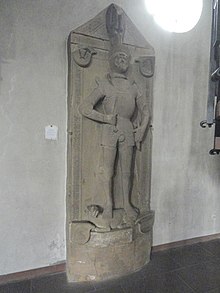Franciscan Church (Würzburg)

The Franciscan Church ( Holy Cross ) is a Catholic church building in Würzburg of the Franciscan Minorite Monastery of Würzburg. The monastery church of the Franciscan Order is located in the city center between Franziskanergasse and Franziskanerplatz.
history
The branch in Würzburg is the oldest in Germany . The Franciscans came to Würzburg in 1221, while the founder of the order, Francis of Assisi (1181 / 82–1226) was still alive . The branch, initially outside the city wall , was moved to the city in 1249. Construction of the church began in the same year. Around 1280 it was completed as a three-aisled basilica with the eastern choir just closed . The choir had a ribbed vault , while the nave was flat-roofed. Under Prince-Bishop Julius Echter von Mespelbrunn , the flat ceilings in the three church naves were removed in 1614 and these vaulted. At the end of the 17th century, the church was given a baroque interior, which was removed again in 1882. During the bombing raid on Würzburg on March 16, 1945 , the church was hit by an explosive device and a large part of it was destroyed. After the roofing of the undamaged choir vault in 1946, reconstruction began in 1947 under government master builder Gustav Heinzmann from Würzburg. An emergency roof was erected over the nave with iron girders and steel pipes. During the actual construction work from 1952 on, this emergency solution with flat wooden ceilings was retained. On October 16, 1954, Bishop Julius Döpfner consecrated the altar. After a roof fire on May 19, 1986, the order decided to restore the nave to its original state before 1614. This measure was brought to a conclusion with the renewed consecration of the altar by Bishop Paul-Werner Scheele on October 3, 1988.
In keeping with the Franciscan simplicity, the church is equipped with only a few works of art:
- The sandstone sacrament altar, made in 1989 by Edmund Borst from Kleinrinderfeld ,
- therein the beautiful tabernacle that Franz Joseph Amberg created in 1954,
- on the left choir wall the statue of St. Francis, created in 1892 by Matthäus Schiestl ,
- above the votive altar of the south aisle the figure of St. Anthony of Padua by the same artist,
- a carved late Gothic Madonna from around 1475 above the votive altar of the north aisle ,
- under the gallery a Pietà from 1515 from the workshop of Tilman Riemenschneider , originally in the Carmelite Church, which was demolished in 1824.
- Another Pietà in a semicircular niche on the north facade shows the epitaph for the innkeeper and Büttner Johann Albert, who died in 1633 (according to Bruhns , it was made by the sculptor Balthasar Grohe, a student of Michael Kern ).
- an epitaph of Anna Zingel, who died in 1407, the wife of the court schultheissen Urban Zingel.
The organ was installed in 1989 by the Peter company in Cologne .
The church houses 18 important tombs from the 14th to 16th centuries.
Web links
literature
- Handbook of German Art Monuments : Bavaria I: Franconia: The administrative districts of Upper Franconia, Middle Franconia and Lower Franconia , Deutscher Kunstverlag, Berlin / Munich 1979, ISBN 3-422-00359-2 , p. 921 f.
- Hanswernfried Muth : Franziskanerkirche Würzburg (= Small Art Guide No. 2262). Schnell & Steiner publishing house, Regensburg 1996.
Individual evidence
- ↑ Leo Bruhns: Würzburg sculptors of the Renaissance and the nascent Baroque 1540-1650. Weizinger, Munich 1923, p. 449 f.
- ↑ Parish of the Birth of Mary in Höchberg: The seven cases .
- ↑ Stefan Kummer : Architecture and fine arts from the beginnings of the Renaissance to the end of the Baroque. In: Ulrich Wagner (Hrsg.): History of the city of Würzburg. Volume 2: From the Peasants' War in 1525 to the transition to the Kingdom of Bavaria in 1814. Theiss, Stuttgart 2004, ISBN 3-8062-1477-8 , pp. 576–678 and 942–952, here: pp. 611 f. and 944.
- ^ Wolfgang Schneider: Folk culture and everyday life. In: Ulrich Wagner (Hrsg.): History of the city of Würzburg. Volume 1: From the beginning to the outbreak of the Peasants' War. Theiss, Stuttgart 2001 ISBN 3-8062-1465-4 , pp. 491-514 and 661-665, here: pp. 511 f.
- ↑ Stefan Kummer: Architecture and fine arts from the beginnings of the Renaissance to the end of the Baroque. 2004, p. 599 f.
Coordinates: 49 ° 47 ′ 28.2 " N , 9 ° 55 ′ 49.7" E



